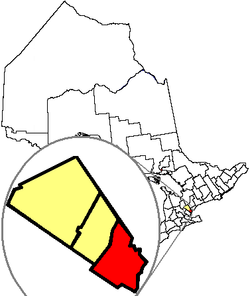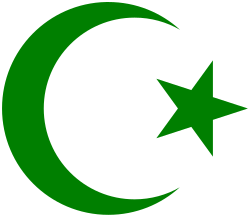Mississauga
Mississauga, Ontario is the sixth-largest city in Canada and the third largest city in Ontario (after Toronto and Ottawa). It borders the largest city in Canada, Toronto. In fact, it is a part of the Greater Toronto Area. Toronto Pearson International Airport is in Mississauga.
| City of Mississauga | |
 | |
|
| |
 Location of Mississauga in the Regional Municipality of Peel in the province of Ontario | |
| Coordinates: 43°36′N 79°39′W / 43.600°N 79.650°WCoordinates: 43°36′N 79°39′W / 43.600°N 79.650°W | |
| Country | Canada |
| Province | Ontario |
| Region | Peel |
| Established | 1968, as a town |
| Incorporated | 1974, as a city |
| Government | |
| • Mayor | Bonnie Crombie |
| • Council | Mississauga City Council |
| • MPs | List of MPs
|
| • MPPs | List of MPPs
|
| Area | |
| • Total | 292.40 km2 (112.90 sq mi) |
| Elevation | 156 m (512 ft) |
| Population (2016) | |
| • Total | 721,119 (6th) |
| • Density | 2,439.9/km2 (6,319/sq mi) |
| Time zone | UTC−5 (EST) |
| • Summer (DST) | UTC−4 (EDT) |
| Postal code span | L4T to L5W |
| Website | www.mississauga.ca |
Visitor attractions
- Art Gallery of Mississauga, a free gallery in the Civic Centre showcasing local art
- Benares Historic House
- Bradley House Museum
- Living Arts Centre, a showcase for the arts
- Opera Mississauga
- Heritage Mississauga
- Portuguese Cultural Centre of Mississauga
- Renaissance Catering & Convention Centre
History
On August 2, 1805, Toronto Township was formed when officials from York (what is now the City of Toronto) purchased 84,000 acres (340 km²) of land from the Mississaugas. In January 2010, the Mississaugas and the federal government settled a land claim. The aboriginal people received $145,000,000 from that.[2]
After the land was surveyed, much of it was given in the form of land grants to United Empire Loyalists. They emigrated from the Thirteen Colonies during and after the American Revolution, as well as loyalists from New Brunswick. A group of settlers from New York City arrived in the 1830s. In 1820, the government purchased additional land from the Mississaugas. Additional settlements were established, including: Barbertown, Britannia, Burnhamthorpe, Derry West, Elmbank, Malton, Meadowvale Village, Mount Charles, and Streetsville. European-Canadian growth led to the eventual displacement of the Mississaugas. In 1847, the government relocated them to a reserve in the Grand River Valley, near present-day Hagersville.[3][4]
In 1873, the Toronto Township Council was formed to oversee the events of the various villages that were unincorporated at that time. The council's responsibilities included road maintenance, and a police force. Most of present-day Mississauga was agricultural land: including fruit orchards, through much of the 19th and first half of the 20th century. Exceptions included small villages, some gristmills and brickworks served by railway lines,[5][6]
In the 1920s, cottages were constructed along the shores of Lake Ontario for people who lived in the city. 17 years later in 1937, 1,410.8 acres of land was sold to build the Malton Airport (later known as the Pearson Airport). It became Canada's busiest airport which also put the end to the community of Elmank.[7]
The township settlements of Lakeview, Cooksville, Lorne Park, Clarkson, Erindale, Sheridan, Dixie, Meadowvale Village, and Malton were combined in 1968 to form the Town of Mississauga. At the time, both Port Credit and Streetsville were left out and remained separate. The town name was chosen by voting. In 1974, Port Credit and Streetsville became part of Mississauga. In that same year, the Square One Shopping Centre opened.[8]
On November 10, 1979, a freight train left its tracks on the Canadian Pacific rail line while carrying explosive and poisonous chemicals just north of the intersection of Mavis Road and Dundas Street. One of the tank cars carrying propane exploded. Since other tank cars were carrying chlorine, the decision was made to evacuate nearby residents. With the possibility of a deadly cloud of chlorine gas spreading through Mississauga, 218,000 people were evacuated.[9] Residents were allowed to return home, once the area was safe. It was one of the largest evacuations in North American history.[10]
Geography
Mississauga covers 288.42 square kilometres (111.36 sq mi) of land, with 13 kilometres (8.1 mi) of shoreline on Lake Ontario.[11]
Statistics
Mississauga is a quickly growing and multicultural city. Statistics Canada estimates that Mississauga now has 704,000 people, an increase of 150,000 from the previous decade and the population has almost doubled in the past twenty years.
Law and Government
The city of Mississauga has only had four mayors in its past and it was created in 1974. This is because in Mississauga usually mayors serve for a very long time. For example, Hazel McCallion, 99, has been mayor from 1978. The current mayor is Bonnie Crombie who assumed office in December 2014.
- Mayors
- Dr. Martin L. Dobkin 1974-1976
- Ron A. Searle 1976-1978
- Hazel McCallion 1978-2014
- Bonnie Crombie 2014-now
- Council
Mississauga is split into 11 wards (parts) each of them having their own councillor.
- Ward 1 Stephen Dasko
- Ward 2 Karen Ras
- Ward 3 Chris Fonseca
- Ward 4 John Kovac
- Ward 5 Carolyn Parrish
- Ward 6 Ron Starr
- Ward 7 Dipka Damerla
- Ward 8 Matt Mohoney
- Ward 9 Pat Saito
- Ward 10 Sue McFadden
- Ward 11 George Carlson
Also, Mississauga is the largest city in Canada where there are more women in the council than men.
- Federal and Provincial Ridings
Mississauga has six legislative (government) ridings that are the same for the Canadian government and the Ontario government. The Canadian government has people in charge of those ridings called M.P.'s (Member of Parliament) and the Ontario government has M.P.P.'s (Member of Provincial Parliament) in charge of them.
- Bramalea-Gore-Malton
- M.P.: Gurbax Malhi (Liberal)
- M.P.P.: Kuldip Kular (Liberal)
- Mississauga-Erindale
- M.P.: Bob Dechert (Conservative)
- M.P.P.: Harinder Takhar (Liberal)
- Mississauga-Brampton South
- M.P.: Navdeep Bains (Liberal)
- M.P.P: Amrit Mangat (Liberal)
- Mississauga East-Cooksville
- M.P.: Albina Guarnieri (Liberal)
- M.P.P.:
- Mississauga South
- M.P.:
- M.P.P.: Charles Sousa (Liberal)
- Mississauga-Streetsville
- M.P.: Gagan Sikand (Liberal, 2015-now)
- M.P.P.: Nina Tangri (PC, 2018-now)
Mississauga Media
Absolute World, condominiums in the City Centre
References
- ↑ "Demonyms—From coast to coast to coast — Language articles — Language Portal of Canada". www.noslangues-ourlanguages.gc.ca. Archived from the original on 30 August 2014. Retrieved 24 August 2014.
- ↑ "Feds offer to settle land claims". Mississauga News. 2010-01-27. Retrieved 21 November 2014.
- ↑ "City History". Archived from the original on 26 September 2014. Retrieved 21 November 2014.
- ↑ "Part One 1819–1850" (PDF). Retrieved 21 November 2014.
- ↑ "Mississauga Real Estate" (PDF). Retrieved 22 November 2014.
- ↑ "Heritage Mississauga – History". Retrieved 21 November 2014.
- ↑ Cook, Dave (2010). Fading History Vol. 2. Mississauga, Ontario: David L. Cook. p. 158. ISBN 978-0-9734265-3-3.
- ↑ "1968 – Amalgamation to form the Town of Mississauga". mississauga.ca. Retrieved 24 August 2014.
- ↑ "Missisauga Train Derailment". mississauga.ca. Retrieved 14 September 2011.
- ↑ "Mississauga train derailment, November 10, 1979". Retrieved 25 September 2014.
- ↑ "Community Profile, City of Mississauga". Statistics Canada, 2006 Census of Population. 2007-03-13. Archived from the original on 12 September 2007. Retrieved 2014-11-21.









